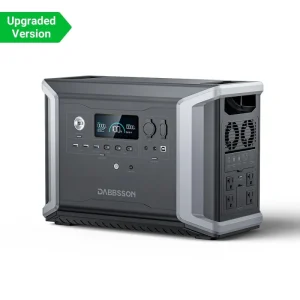Power Station Use Benefits We all do, and fortunately we now have power stations that offer a clean, quiet, portable and extremely efficient power source which can be utilised for outdoor activities as well as to survive off-grid! Additionally, these systems are driven by lithium-ion or lithum-iron-phosphate (LiFePO4) batteries which provide high energy density and long cycle life supporting typically 500 to 2,000 charge cycles. This is in contrast to a power station that can store an enormous amount of electricity 2000-plus Wh worth—in the example above, the Dabbsson DBS2300 could give you all the juice of a mini-fridge and laptops and LED lights for days on it's over 480,000 mAh (that's about half-a-million mAH) provided you've used them both sparingly.
Clean power from power stations is one of our main applications — 100% emissions-free. Fuel storage also presents challenges to even small engines, but solar-powered battery stations completely eliminate the need for a fuel source which means that there are absolutely no emissions to worry about as well. They are also very silent with noise levels around 30-40 decibels, rather than the 70-90 decibels that gas generators operate at. This silent operation allows the power stations to be valuable camping, RV and residential backup solutions.
Additionally, the power stations are extremely efficient as a result of their advanced inverter technology — efficiently converting DC to AC with very little energy loss. Good-quality ones in pure sine wave inverters allow them to provide stable and clean power suitable for electronics that are sensitive in nature. This means that a 2000 Wh station like mine can charge a smartphone over 200 times or light up a 60-watt LED with almost 30 hours of juice in one charge, which provides an energy savings that is not only easy to install and use but also very low-cost and efficient.

Various charging methods such as AC, DC and solar input are supported by a host of modern-day power station. In an off-grid or remote setting, solar charging can be quite useful as it enables users to replenish the battery using renewable energy. In ideal conditions, where it is getting close to 6 hours of full sunlight average daily a 100-watt solar panel can probably put back 500 Wh in a day, and the power station should be working for unlimited time with anti-energy-disadvantage. It also has led sales of solar-ready power station to increase 30% in the past three years – a information tidbit courtesy of a piece by GreenTech Media, which underscores growing interest for sustainable energy options.
In addition to providing peace of mind when it comes to power during emergencies. Electricity is inopportune and when it comes to natural disasters (hurricanes, wildfires) back-up sources could potentially be a lifeline. Power station typically come with a strong battery management system (BMS) which helps an individual to be safe as it can avoid any serious issues such as overcharging, short-circuiting, overheating etc and they became a more safe option for households. Power station, with their portability, durability and versatility are becoming significantly relevant in contemporary energy solutions, providing sound ecological alternatives to conventional generators for a myriad of applications.